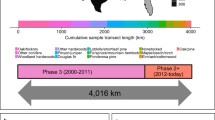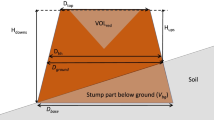Abstract
The Swiss National Forest Inventory (NFI) is expected to provide reliable data about the current state of the Swiss forests and recent changes. Since the first Swiss NFI (1982–1986) a deadwood assessment has been part of the inventory. However, the definition of deadwood used was restricted and only parts of the total deadwood volume were assessed. A broader definition was therefore used in the second NFI (1993–1995) and coarse wood debris (CWD) was also assessed using line intersect sampling in the third NFI (2004–2006). This paper discusses the development of the definition of deadwood from the first to the third Swiss NFI, as well as the tally rules and estimators used in assessing deadwood in the ongoing third NFI. Different definitions of deadwood were applied in two Swiss regions and the resulting volume estimates were compared. The definition of deadwood appears to be crucial for the estimate of deadwood volumes, which were significantly underestimated in the first and second Swiss NFI. The minimum diameter and other limits applied must be chosen with special care. Up to 30 m3/ha of deadwood was found in Swiss forests varying with the region. There was little evidence of significant correlations between deadwood volume and such forest parameters as management, site or stand attributes. The proposed target values for the volume of deadwood have been generally reached, whereas the number of snags per hectare has not.




Similar content being viewed by others
Notes
Saproxylic species: species depending on dead or decaying wood during a part of their life cycle.
References
Bell G et al (1996) Accuracy of the line intersect method of post-logging sampling under orientation bias. For Ecol Manage 84:23–28
Böhl J (2005) Aufnahme von liegendem Totholz. In: Keller M (ed) Schweizerisches Landesforstinventar. Anleitung für die Felderhebungen 2004–2007, Swiss Federal Research Institute WSL, Birmensdorf
Brändli UB (2001) Nature protection function. In: Brassel P, Lischke H (eds) Swiss National Forest Inventory: methods and models of the second assessment. Swiss Federal Research Institute WSL, Birmensdorf, pp 265–282
Brändli UB (2005) Biological diversity. Dead wood, Chapter 4.5. In: SAEFL, WSL (eds) Forest report 2005—facts and figures about the condition of Swiss forests, pp 84–85
Brändli UB, Ulmer U (1999) Naturschutz und Erholung. In: Brassel P, Brändli UB (eds) Scweizerisches Landesforstinventar. Ergebnisse der Zweitaufnahme 1993–1995, pp 279–329
Brassel P, Lischke H (2001) Swiss National Forest Inventory: methods and models of the second assessment. Swiss Federal Research Institute WSL, Birmensdorf
Brown JK (1974) Handbook for inventorying downed woody material, USDA For. Serv. Gen. Tech. Rep. INT-16
Brown JK, Roussopoulos PJ (1974) Eliminating biases in the planar intersect method for estimating volumes of small fuels. Forest Sci 20:350–356
Bättig C, Bächtiger C, Bernasconi A, Brändli UB, Brassel P (2002) Landesforstinventar—Wirkungsanalyse zu LFI1 und 2 und Bedarfsanalyse für das LFI3. Umwelt—Materialien Nr. 143. Bundesamt für Umwelt, Wald und Landschaft BUWAL
Bütler R (2003) Dead wood in managed forests: how much and how much is enough? Development of a snag quantification method by remote sensing and GIS and snag targets based on the three-toed woodpecker’s habitat requirements. Thèse de doctorat No 2761 Faculté Environnement naturel, architectural et construit. Ecole polytechnique fédérale, Lausanne, 184 p
Bütler R, Thibault L, Schlaepfer R (2005) Alt- und Totholzstrategie für die Schweiz: wissenschaftliche Grundlagen und Vorschlag. EPFL, Lausanne, im Auftrag des Bundesamtes für Umwelt, Wald und Landschaft BUWAL. Unpublished
Commarmot B, Bachofen H, Bundziak Y, Bürgi A, Ramp B, Shparyk Y, Sukhariuk D, Viter R, Zingg A (2005) Structures of virgin and managed beech forests in Uholka (Ukraine) and Sihlwald (Switzerland): a comparative study. In: Commarmot B (ed) Natural forests in the temperate zone of Europe: biological, social and economic aspects. For. Snow Landsc. Res. 79:(1/2):45–56
Gregoire TG, Valentine HT (2003) Line intersect sampling: Ell-shaped transects and multiple intersections. Environ Ecol Stat 10:263–279
Hahn P, Haynen D, Indermühle M, Mollet P, Birrer S (2005) Holznutzung und Naturschutz, Praxishilfe. Vollzug Umwelt. Bundesamt für Umwelt, Wald und Landschaft und Schweizerische Vogelwarte. Bern und Sempach
Howard JO, Ward FR (1972) Measurement of logging residue— alternative applications of the line—intersect method. Research Note PNW-183, USDA Forest Service, Portland
Kaiser L (1983) Unbiased estimation in line-intercept sampling. Biometrics 39:965–976
Kaufmann E (2001) Estimation of standing timber, growth and cut. In: Brassel P, Lischke H (eds) (2001) Swiss National Forest Inventory: methods and models of the second assessment. Swiss Federal Research Institute WSL, Birmensdorf
Keller M (2005) Schweizerisches Landesforstinventar. Anleitung für die Felderhebungen 2004–2007. Swiss Federal Research Institute WSL, Birmensdorf
Kleinn C (1994) Comparison of the performance of line sampling to other forms of cluster sampling. For Ecol Manage 68:365–373
Köhl M (1994) Statistisches Design für das zweite Schweizerische Landesforstinventar: Ein Folgeinventurkonzept unter Verwendung von Luftbildern und terrestrischen Aufnahmen. Mitteilungen der Eidgenössischen Forschungsanstalt für Wald, Schnee und Landschaft Band 69, Heft1
Linnell Nemec AF, Davis G (2002) Efficency of six line intersect sampling designs for estimating volume and density of coarse woody debris. Technical Report (TR-021) Vancouver Forest Region
Marshall PL et al (2000) Using line intersect sampling for coarse woody debris. Technical Report (TR-003), Vancouver Forest Region
MCPFE (2003) Improved pan-European indicators for sustainable forest management: as adopted by the MCPFE Expert Level Meeting 7–8 October 2002, Vienna, Austria
Möller G (1994) Alt- und Totholzlebensräume; Ökologie, Gefährdungssituation, Schutzmassnahmen. Beitr Forstwirtsch Landsch ökol 28:7–15
Roth A, Kennel E, Knoke Th, Matthes U (2003) Die Linien-Intersekt-Stichprobe: Ein effizientes Verfahren zur Erfassung von liegendem Totholz? Forstwissenschaftliches Centralblatt 122:318–336
Schiegg-Pasinelli K, Suter W (2002) Lebensraum Totholz. 2. Aufl. WSL, Merkbl. Prax. 33:6 p
Ståhl G, Lämås T (1998) Assessment of coarse woody debris, European Forest Institute (EFI) Proceedings No. 18:241–248
Ståhl G, Ringvall A, Fridman J (2001) Assessment of coarse woody debris—a methodological overview. Ecol Bull 49:57–70
Stierlin HR, Brändli UB, Herold A, Zinggeler J et al (1994) Schweizerisches Forstinventar—Anleitung für die Feldaufnahmen der Erhebung 1993–1995. Swiss Federal Research Institute WSL, Birmensdorf
Vries PG de (1986) Sampling theory for forest inventory. Springer, Heidelberg
Wadell KL (2001) Sampling coarse woody debris for multiple attributes in extensive resource inventories. Ecol Indic 1:139–153
van Wagner CE (1968) The line intersect method in forest fuel sampling. For Sci 14:20–26
van Wagner CE (1982) Practical aspects of the line intersect method, Information Report PI-X-12
Warren WG, Olsen PF (1964) A line intersect technique for assessing logging waste. For Sci 13:267–276
Author information
Authors and Affiliations
Corresponding author
Additional information
Communicated by Hans Pretzsch.
Rights and permissions
About this article
Cite this article
Böhl, J., Brändli, UB. Deadwood volume assessment in the third Swiss National Forest Inventory: methods and first results. Eur J Forest Res 126, 449–457 (2007). https://doi.org/10.1007/s10342-007-0169-3
Received:
Accepted:
Published:
Issue Date:
DOI: https://doi.org/10.1007/s10342-007-0169-3




